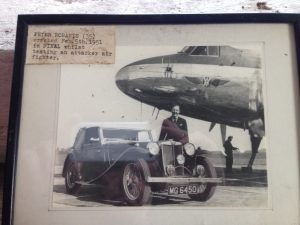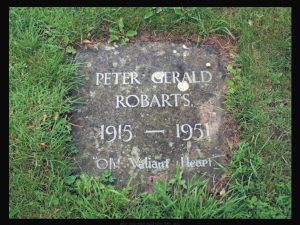Some interesting information regarding Sqdn Ldr Peter Gerald Robarts has recently been shared with the Robarts family, courtesy of Mick Dowdeswell.
The 1951 Minal air crash
It was February the 5th 1951 and I was stood in the playground of Mayfield College, when a jet plane flew over, quite low, roughly from S/W to N/E and streaming extremely black smoke. Shortly after, there was a crash in the distance and it was obvious to me that the plane had crashed.
Mayfield College, was a mixed day and boarding school in Marlborough, on the A4. I had been a boarder since 1949; us boys had been boarded at St Katharine’s in Savernake Forest; the girls at Glebe House, in Minal. Sometime late in 1950, we did a swap and we found ourselves at Glebe House.
When we returned from school on that February day, we heard that a plane had crashed up the lane, which I now know as Woodlands Road. However, we were not allowed to go anywhere near there, but we were told that there was a huge crater there and the pilot was killed.
For many years, I tried to find out about the crash, even coming over to Minal from Lambourn to the Horseshoe pub, but no-one ever knew anything about it! Even the Wiltshire Gazette and Herald! And, they had never heard of Mayfield College either!
I was under the impression that it was a Meteor jet that crashed, as they had a bad reputation, but no such information on line was forthcoming in that direction.
Suddenly, earlier this year, I had a very chance meeting at a chiropractor’s in Little Bedwyn, with Tom Seaman, who I’d never met before. We got chatting and I happened to mention Mayfield College and the plane crash and he then said that the plane just missed his family’s house by ten feet, took out the top of a fir tree up the garden and crashed in one of their fields up the lane. He had the name of the pilot as James Roberts and that there was a picture of him in the local church. He also knew about Mayfield College, in that when it closed (that’s another story), he demolished it and used the bricks to build houses!
Tom also made reference to a briefcase that was ‘thrown’ clear of the plane when it crashed and strangely, had not a mark on it when it was found. However, I’ve not found any evidence of that so far, as very few people know about the crash anyway.
With this new information, I looked-for James Roberts on military files on the Internet. No such luck, but I found Canon Andrew Studdert-Kennedy’s details on-line and contacted him about the picture. He didn’t know about it, but immediately looked for it; found it, took a picture of it and emailed it to me.
Now I was getting somewhere, because a caption at the corner of the photo read: ‘PETER ROBARTS (35) crashed Feb 5th. 1951 in MINAL whilst testing an attacker air fighter’.
He is stood alongside an MG TC (I think) sports car with an Airwork transport plane behind him.
From this new information, I could find out that he was born of a wealthy Banking family on the 5th of July 1915. He flew as a S/Ldr for the RAF during the war and left on the 24th of November 1945, to join the Aviation Department of Vickers Armstrong Ltd at Weybridge in Surrey.
He flew a Spitfire trainer 8 in the Kings Cup race in 1950, establishing a world record in the 100km closed circuit with a speed of 328mph.
Looking at the photo of Peter Robarts, he is in front of a plane bearing the company logo of Airwork Ltd., or Airwork Services Ltd. This was a company founded in 1928 and eventually covered a multitude of roles, from pilot training, aircraft modification to contract charter flying. This photo may well have been taken at Blackbushe Airport.
A comprehensive history of Airwork is found on line at www.woolleyfamily.co.uk/Airwork.htm
On the 5th of February 1951, Sqn Ldr P.G. Robarts was flying a Supermarine Attacker F Mk1 WA477, taking off from South Marston, Wiltshire (Now the home of Honda, Swindon).
This was the third production test flight, proving pressurisation and effect on performance of ventral tank.
On take-off, puffs of black smoke were seen in the jet efflux. The aircraft was next seen at high speed pulling out of a dive, then rolling inverted, before impacting the ground at well over 500 m.p.h. Peter Gerald Robarts was 35 when he died.
Having thought for years, as I said, that it was a Meteor jet that crashed; with the information on the picture, I found out that it was indeed a Supermarine Attacker. The first prototype had first flown in 1946, but did not enter production until 1954. The RAF abandoned it, but it found favour with the Royal Navy for a short while until it was phased out in 1954. It was therefore, not a successful aircraft.
Arranging to meet with Canon Andrew one day earlier this year at Minal Church, I presented him with this information and he now has it in the church.
Very luckily, directly after meeting with Andrew, I met Stephen Hurd at Glebe House. I had been boarded there of course, but had never been there since the school closed, sometime in 1951. (Another story). I could not remember too much about it, but Stephen invited my wife and I into the magnificent garden to take photos of that and the beautiful house.
I was fortunate enough to be carrying three sets of the crash history, so I gave Andrew a set also.
It was then up to the Horseshoe pub, where, gladly, I met up with Tom Seaman for the second time.
I learned of the crash site, as I had brought an Ordnance Survey map with me. Tom, at that time, lived more in the village than he does now on the outskirts.
Also, I had always thought that Mayfield College was on the site of where T.H. White is now, with the house fronting the A4 as part of it, but I was put in my place when Tom said that he had demolished all of it at the time.
I therefore gave Tom my third set of information and photos.
Peter Gerald Robarts remains are laid to rest in the grounds of Lillingstone Dayrell’s St. Nicholas’ churchyard, where other members of his family are also buried. On a website : Peter Gerald Robarts 1951 (2) Lillingstone Dayrell (https://www.flickr.com/photos) shows the church and the headstones of the Robarts family, particularly of P.G.Robarts.



